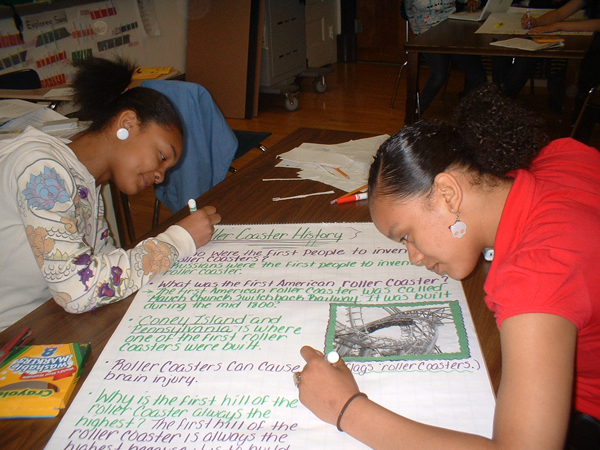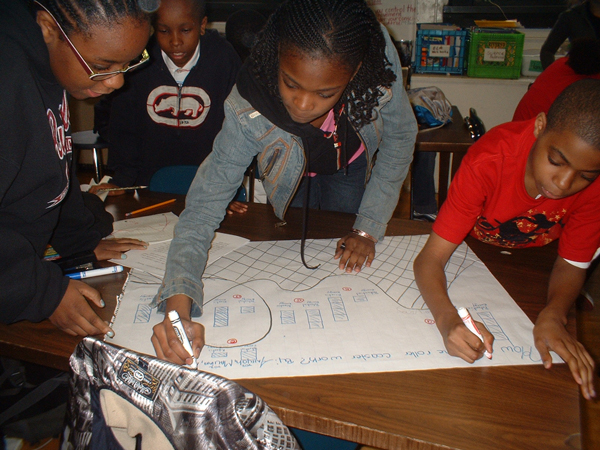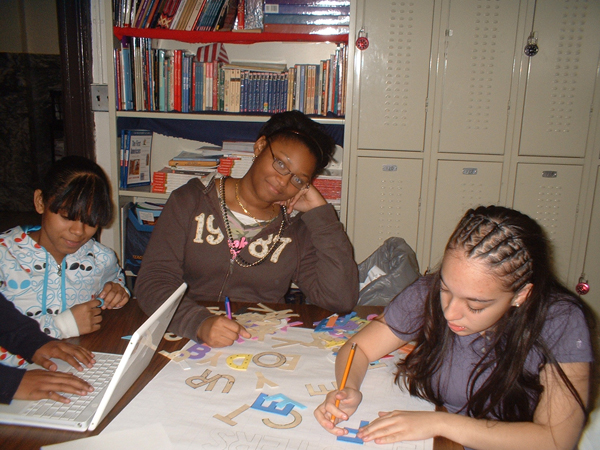Universal Studios' Roller Coasters
| Name: |
Asli Aydin |
| School: |
Park Place Community Middle School 266 |
| Address: |
62 Park Place |
| City: |
Brooklyn, NY, 11217 |
| Original Project: |
Universal Studios' Roller Coasters |
| Author: |
Ms.Vitulano |
| URL: |
http://teachersnetwork.org/teachnetnyc/jvitulano/universal.htm |
How did you modify this unit for use in your own classroom?: I used the idea of roller coasters to explain the science behind it in addition to the thrill of it. For instance, in order to discuss and undersrtand kinetic energy and potential energy, we looked at roller coasters. One assignment was to study the history of roller coasters. Students had some guiding questions for their research, such as, "Who were the 1st people to invent roller coasters in the world and in the United States?" They also had to take their own notes. Materials included: Internet access, pen, paper, chart paper, markers and related pictures. http://science.howstuffworks.com/roller-coaster.htm provided information regarding: The Science of Roller Coasters- potential energy vs. kinetic energy and Roller Coasters and Your Body.
List your primary instructional objectives for your students.
| |
Students will be able to discuss the history of roller coasters. |
| |
Students will be able to discuss the energy being used by the roller coasters. |
| |
Students will be able to discuss the way roller coaster rides make one's body feel. |
| |
|
What role did technology play in this curriculum unit?: Students used laptop computers to research informaton on the various objectives. Some sites, helped them understand the way roller coasters work. The following website is very informative and has the break down of all the information about the roller coasters: http://science.howstuffworks.com/roller-coaster.htm The following website has information and includes links to various sites. http://glencoe.com/sec/science/webquest/content/rollercoast.shtml
How did you assess and evaluate student performance?: Students worked in groups and each group had a different objective. Each person in the group had a different job. At the end of their work, students were asked to present and discuss their projects. I asked students questions and assessed them with their end product sand responses to the questions.
Please tell us briefly about your background & teaching experience: Asli Aydin has been teaching for the past three years. She likes to teach science to her middle school students. Her students are always interested and curious. She graduated from Hunter College and did her masters in education.
What are your recommendations for other teachers interested in adapting this unit?: I think this unit can be thought of as cross curriculum. There is so much to do in a variety of subject areas. The social studies department can take the historical aspect. The math department can examine the calculations such as those used to determine speed.
Modifications: I basically took the idea of roller coasters and I wanted students to see the science behind roller coasters besides the thrill of it.
Assignments- History behind roller coasters. Students had some guiding questions for their research and they also had to take their own notes. Who were the 1st people to invent roller coasters in the world and United States?
Materials: Internet access, pen, paper, chart paper, markers and related pictures. The Science of Roller coasters- potential energy vs. kinetic energy Roller coasters and your body. The following website is very informative and has the break down of all the information about the roller coaters. http://science.howstuffworks.com/roller-coaster.htm
The following website has information and includes links to various sites. http://glencoe.com/sec/science/webquest/content/rollercoast.shtml
Assessment: Rubric Category 100% 85% 70% 55% Scientific Knowledge Clear evidence of scientific principles. Explanation by all group members and accurate understanding of scientific principles. Clear evidence and missing somewhat information about scientific principles Some evidence of research Little or no evidence that supports or explains the task Data Collection Collected accurately Somewhat collected Partially completed Presentation Complete, well presented Generally complete Somewhat complete Did not communicate well Modifications: I basically took the idea of roller coasters and I wanted students to see the science behind roller coasters besides the thrill of it.
Assignments- History behind roller coasters. Students had some guiding questions for their research and they also had to take their own notes. Who were the 1st people to invent roller coasters in the world and United States? Materials: Internet access, pen, paper, chart paper, markers and related pictures. The Science of Roller coasters- potential energy vs. kinetic energy Roller coasters and your body.
The following website is very informative and has the break down of all the information about the roller coaters. http://science.howstuffworks.com/roller-coaster.htm The following website has information and includes links to various sites. http://glencoe.com/sec/science/webquest/content/rollercoast.shtml Assessment: Rubric Category 100% 85% 70% 55% Scientific Knowledge Clear evidence of scientific principles. Explanation by all group members and accurate understanding of scientific principles. Clear evidence and missing somewhat information about scientific principles Some evidence of research Little or no evidence that supports or explains the task Data Collection Collected accurately Somewhat collected Partially completed Presentation Complete, well presented Generally complete Somewhat complete Did not communicate well Modifications: I basically took the idea of roller coasters and I wanted students to see the science behind roller coasters besides the thrill of it. Assignments- History behind roller coasters. Students had some guiding questions for their research and they also had to take their own notes. Who were the 1st people to invent roller coasters in the world and United States? Materials: Internet access, pen, paper, chart paper, markers and related pictures. The Science of Roller coasters- potential energy vs. kinetic energy Roller coasters and your body. The following website is very informative and has the break down of all the information about the roller coaters. http://science.howstuffworks.com/roller-coaster.htm The following website has information and includes links to various sites. http://glencoe.com/sec/science/webquest/content/rollercoast.shtml Assessment: Rubric Category 100% 85% 70% 55% Scientific Knowledge Clear evidence of scientific principles. Explanation by all group members and accurate understanding of scientific principles. Clear evidence and missing somewhat information about scientific principles Some evidence of research Little or no evidence that supports or explains the task Data Collection Collected accurately Somewhat collected Partially completed Presentation Complete, well presented Generally complete Somewhat complete Did not communicate well
Samples of Student Projects
| |
This group of students researched first founders of roller coasters in the world and the United States. |
| |
 |
| |
|
| |
This group worked on the way roller coasters worked and the way kinetic energy and potential energy are involved. This group also drew diagrams of roller coasters at work to explain the energy use. |
| |
 |
| |
|
| |
This group simply looked at different terms such as velocity, accleration etc. to explain the motion of roller coasters.,Students writing all of their findings about the history of roller coasters. |
| |
 |
| |
|
| |
|
| |
 |
| |
AsliAydin.doc |
|